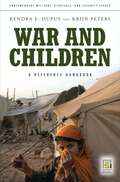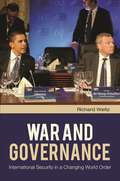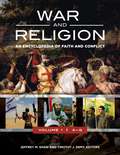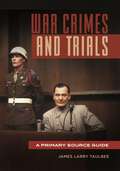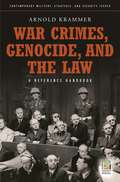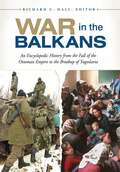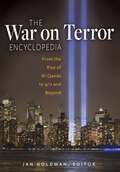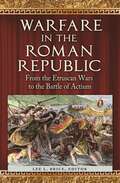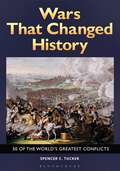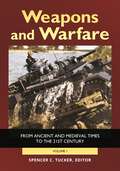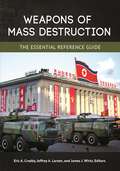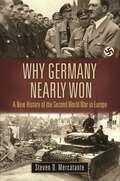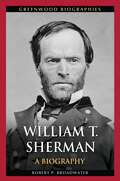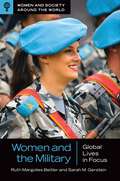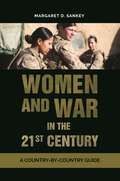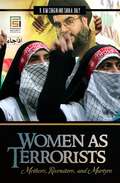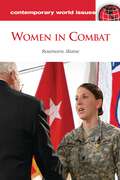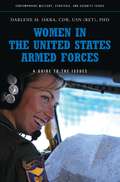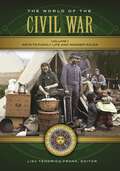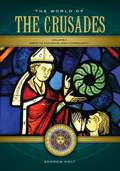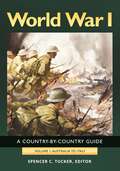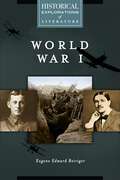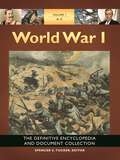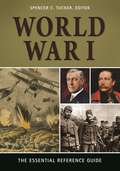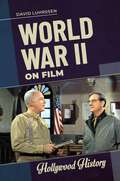- Table View
- List View
War and Children: A Reference Handbook (Contemporary Military, Strategic, and Security Issues)
by Kendra E. Dupuy Krijn PetersA comprehensive, up-to-date presentation of how children and young people are affected by and respond to situations of armed conflict and postwar reconstruction.War and Children: A Reference Handbook looks at one of the most wrenching aspects of armed conflict, ranging across the globe to examine the different ways armed conflict and postwar reconstructions affect children and young people, and how they have responded to both war and efforts to alleviate war's destruction.While war has always affected children, the nature of that impact has changed in the last half-century. Civil conflicts break out in mostly poor, developing countries with large populations of young people, and combatants are less hesitant to turn civilian areas into battlegrounds. War and Children explores these phenomena by focusing primarily on recent conflicts worldwide, with case studies dramatizing important issues and controversies-including the considerable number of children soldiers throughout the world.
War and Governance: International Security in a Changing World Order (The Changing Face of War)
by Richard WeitzAn insightful and expert assessment examines how best to end—and avert—wars.How do we avoid war? To arrive at an answer, master analyst Richard Weitz explores the ways nations, international organizations, and individuals have sought to bring order to an inherently disorderly phenomenon—potential and actual violent conflict among organized political entities. Specifically, War and Governance: International Security in a Changing World Order analyzes a number of critical issues such as whether regional security institutions have distinct advantages and liabilities in promoting international security, as compared with universal organizations like the United Nations. Other important questions are addressed, as well. How will international organizations, such as the UN, EU, and NATO, change the nature of war in the 21st century—and be changed by it? What role might less formal institutions and nongovernmental organizations play in peacemaking? Will the nation-state remain the most important international security actor? The book ends with a gap analysis that identifies incongruities between international needs and capabilities—and suggests ways to overcome them.
War and Religion [3 volumes]: An Encyclopedia of Faith and Conflict [3 volumes]
by Jeffrey M. Shaw and Timothy J. Demy EditorsThis three-volume reference provides a complete guide for readers investigating the crucial interplay between war and religion from ancient times until today, enabling a deeper understanding of the role of religious wars across cultures.Containing some 500 entries covering the interaction between war and religion from ancient times, the three-volume War and Religion: An Encyclopedia of Faith and Conflict provides students with an invaluable reference source for examining two of the most important phenomena impacting society today. This all-inclusive reference work will serve readers researching specific religious traditions, historical eras, wars, battles, or influential individuals across all time periods.The A–Z entries document ancient events and movements such as the First Crusade that began at the end of the 10th century as well as modern-day developments like ISIS and Al Qaeda. Subtopics throughout the encyclopedia include religious and military leaders or other key people, ideas, and weapons, and comprehensive examinations of each of the major religious traditions' views on war and violence are presented. The work also includes dozens of primary source documents—each introduced by a headnote—that enable readers to go directly to the source of information and better grasp its historical significance. The in-depth content of this set benefits high school and college students as well as scholars and general readers.
War Crimes and Trials: A Primary Source Guide
by James Larry TaulbeeThis comprehensive reference work serves as an important resource for anyone interested in the international prosecution of war crimes and how it has evolved.War Crimes and Trials analyzes the evolution of war crime trials through primary sources. Beginning with a general discussion of why regulations for war have evolved, it then illustrates the resulting changes in the nature and consequences of war as well as attitudes toward war as a part of international life. Moreover, it contextualizes contemporary rules that pertain to both international and non-international armed conflicts.The heart of the book focuses on 12 World War II cases central to the development of war law over the next 50 years, including the Nuremberg and Tokyo trials of major war criminals. It additionally dedicates discussion to the evolution of the law after World War II as set in motion by the United Nations, the 1949 Geneva Conventions and amendments, the background and operation of the ad hoc international criminal courts, and the creation of the permanent International Criminal Court, illustrating problems and successes through 12 cases drawn from these four courts.
War Crimes, Genocide, and the Law: A Guide to the Issues (Contemporary Military, Strategic, and Security Issues)
by Arnold KrammerThis timely handbook offers an examination of man's history of war crimes and the parallel development of rules of war to prevent them in the future.Kosovo, Rwanda, Sierra Leone, Darfur, Auschwitz. War crimes have occurred in regions around the world and continue to this day. Although atrocities are as old as war itself, they did not become punishable crimes until the law evolved to define them as such. War Crimes, Genocide, and the Law: A Guide to the Issues examines the types of war crimes and the motivations behind them, as well as the laws that seek to control and abolish these heinous acts.Within the handbook, centuries of war crimes and genocides are analyzed and catalogued. At the same time, the author offers a history of the development of the rules of war, enabling readers to grasp the importance of such precedent-setting events as the 1946 Nuremberg Trials, and to see the gradual evolution of the laws intended to punish perpetrators and prevent future barbarism.
War in the Balkans: An Encyclopedic History from the Fall of the Ottoman Empire to the Breakup of Yugoslavia
by Richard C. Hall Jon C. Anderson Jr. Virginia Military Institute Walter F. Bell Bestami S. Bilgic Anna Boros Dino E. Buenviaje Frhs Antoine Capet Bert Chapman Bernard Cook Maeve Cowan Brig. Gen. Uzal W. Ent Gregory C. Ference Timothy L. Francis James W. Frusetta Neil A. Hamilton Laura J. Hilton Gordon E. Hogg John J. Horton Michael D. Johnson Robert B. Kane Gary Kerley Lucian N. Leustean Bonnie K. Levine-Berggren Alessandro Massignani Lisa McCallum Joseph McCarthy James Brian McNabb Karen Mead Marko Milivojevic Alexander Mikaberidze Josip Mocnik Irina Mukhina Michael S. Neiberg Jason Newman Christian Nuenlist Eric W. Osborne Ahmet Özcan Neville Panthaki Paul G. Pierpaoli Jr. John David Rausch Jr. Annette Richardson Karl Roider Margaret Sankey Mary Kate Schneider Charles R. Shrader Brian G. Smith Eva-Maria Stolberg David Tal James Tallon Brian C. Trueblood Spencer C. Tucker Brandon H. Turner Mesut Uyar Dierk Walter A. J. L. Waskey Tim J. Watts James H. Willbanks Hedley P. Willmott Anna M. Wittmann Fatih Yeşil Gültekin YildizThis authoritative reference follows the history of conflicts in the Balkan Peninsula from the 19th century through the present day.The Balkan Peninsula, which consists of Albania, Bulgaria, Romania, Moldova, and the former Yugoslavia, resides in the southeastern part of the European continent. Its strategic location as well as its long and bloody history of conflict have helped to define the Balkans' role in global affairs. This singular reference focuses on the events, individuals, organizations, and ideas that have made this region an international player and shaped warfare there for hundreds of years.Historian and author Richard C. Hall traces the sociopolitical history of the area, starting with the early internal conflicts as the Balkan states attempted to break away from the Ottoman Empire to the assassination of Archduke Franz Ferdinand that ignited World War I to the Yugoslav Wars that erupted in the 1990s and the subsequent war crimes still being investigated today. Additional coverage focuses on how these countries continue to play an important role in global affairs and international politics.
The War on Terror Encyclopedia: From the Rise of Al-Qaeda to 9/11 and Beyond
by Editor Jan GoldmanThis fascinating reference chronicles the individuals, operations, and events of the War on Terror around the world, exploring its causes and consequences through the lens of policy, doctrine, and tactics of combat.The War on Terror is more than a political movement to identify and prosecute terrorists … it has become a cornerstone of economic and military importance. This campaign has shaped policy in the Middle East, prompted uprisings of Islamic fundamentalists against the West, and redefined the ideology of warfare. This single-volume encyclopedia provides readers with more than 200 engaging entries on the myriad events, key individuals, and organizations that have played a major role in the War on Terror.The A–Z entries define the policies and doctrines; describe the armies, battlefields, and weapons employed; and profile the figures whose actions and decisions set the course of history. The expert contributors decode military jargon for non-specialist readers and explain the unconventional tactics used in the War on Terror, shedding light on the reason behind the attacks, the political maneuvering of the leaders involved, and the internal conflicts and external clashes that drove terrorists to settle all over the world. The book also includes detailed essays on the impact of the September 11 attacks on U.S. foreign policy, presidential powers, and public opinion.
Warfare in the Roman Republic: From the Etruscan Wars to the Battle of Actium
by Lee L. BriceThis easy-to-use reference book covers the most important people, places, events, and technologies of Roman warfare during the republic (400–31 BCE), providing a wealth of reference material and invaluable primary source documents.The study of ancient Rome remains both a high-interest topic and a staple of high school and university curricula, while recent Hollywood movies continue to heighten popular interest in Rome. This multi-format handbook examines warfare in ancient Rome during the republic period, from approximately 400 BCE to 31 BCE. Presenting ready reference, primary source documents, statistical information, and a chronology, the title explore all aspects of conflict during this time period, including key military leaders, pivotal battles and sieges, new weapons and technologies, and the intersections of warfare and society in the ancient world. The reference entries provide detailed snapshots of key people, events, groups, places, weapons systems, and strategies that enable readers to easily understand the critical issues during 400 years of the Roman Republic, while various overview, causes, and consequences essays offer engaging, in-depth coverage of the most important wars. By providing students with in-depth information about how the Roman Army operated, they develop a fuller understanding Roman, ancient, and world history.
Wars That Changed History: 50 of the World's Greatest Conflicts
by Spencer C. TuckerA thorough study of significant wars throughout history and their influence on world affairs—from the Egyptian Pharaoh Thutmore III's Campaigns during 479–459 BCE through the Iraq War of 2003–2011.For hundreds of years, wars have played a determining role in history and have decided the rise and fall of civilizations. Many believe that understanding the causes and consequences of warfare may move humankind towards world peace. This selection of the 50 most consequential wars, compiled by award-winning military historian Spencer C. Tucker, presents each conflict in chronological order and discusses its causes, its course, and its significance in world history.Through thoughtful essays and supporting visual evidence, this reference work examines the types of weapons systems employed and their effects in the field; the roles played by individual leaders such as Alexander the Great, Julius Caesar, Abraham Lincoln, and Adolf Hitler; and the impact of geography and economics on the battlefield. The work includes fascinating information about warfare, addressing subjects such as how transportation and logistics changed the face of war over time, what invention marked the ascendancy of infantry over cavalry, why World War I remains the most important war in the 20th century, and which war killed nearly half of the population of Germany. Each essay includes the latest interpretations of strategy, agendas, and consequences of the featured event.
Weapons and Warfare [2 volumes]: From Ancient and Medieval Times to the 21st Century [2 volumes] (Weapons And Warfare Ser.)
by Spencer C. TuckerThis work covers major weapons throughout human history, beginning with clubs and maces; through crossbows, swords, and gunpowder; up to the hypersonic railgun, lasers, and robotic weapons under development today.Weapons and Warfare is designed to provide students with a comprehensive and highly informative overview of weapons and their impact on the course of human history. In addition to providing basic factual information, this encyclopedia will delve into the greater historical context and significance of each weapon. The chronological organization by time period will enable readers to fully understand the evolution of weapons throughout history.The work begins with a foreword by a top scholar and a detailed introductory essay by the editor that provides an illuminating historical overview of weapons. It then offers entries on more than 650 individual weapons systems. Each entry has sources for further reading. The weapons are presented alphabetically within six time periods, ranging from the prehistoric and ancient periods to the contemporary period. Each period has its own introduction that treats the major trends occurring in that era. In addition, 50 sidebars offer fascinating facts on various weapons. Numerous illustrations throughout the text are also included.
Weapons of Mass Destruction: The Essential Reference Guide
by Eric A. Croddy, Jeffrey A. Larsen, and James J. WirtzWhether one is interested in learning about anthrax, sarin, the neutron bomb—or any other weapon of mass destruction—this thorough and detailed reference is the place to find answers.The threat posed by weapons of mass destruction (WMD), whether nuclear, radiological, chemical, or biological, is the number-one topic of concern for the intelligence community, first responders, policymakers, and myriad non-governmental organizations—and many members of the general public. This authoritative reference will serve all of those parties by covering the full spectrum of mass-casualty weapons. The guide will not only enable people to educate themselves, but also to separate the truth from the spurious information that abounds. The book offers an A-to-Z listing of major topics, making finding information about concepts, scientific theories, and realities of WMD fast and easy. While the framework of WMD goes back centuries, the major focus of this reference is on weapons that date from the use of chemical warfare in World War I. The book also covers WMD from the early nuclear era (World War II), the Cold War, and the present (Syria, North Korea, etc.). Each entry is written in a clear, accessible style and includes crucial background information, making this book an essential resource for both lay readers and specialists. Armed with this portable database, readers will have the confidence to deal with, discuss, or write about WMD of all kinds based on an understanding of relevant concepts, policies, and scientific fundamentals.
Why Germany Nearly Won: A New History of the Second World War in Europe (War, Technology, and History)
by Steven D. MercatanteThis book offers a unique perspective for understanding how and why the Second World War in Europe ended as it did—and why Germany, in attacking the Soviet Union, came far closer to winning the war than is often perceived.Why Germany Nearly Won: A New History of the Second World War in Europe challenges this conventional wisdom in highlighting how the re-establishment of the traditional German art of war—updated to accommodate new weapons systems—paved the way for Germany to forge a considerable military edge over its much larger potential rivals by playing to its qualitative strengths as a continental power. Ironically, these methodologies also created and exacerbated internal contradictions that undermined the same war machine and left it vulnerable to enemies with the capacity to adapt and build on potent military traditions of their own.The book begins by examining topics such as the methods by which the German economy and military prepared for war, the German military establishment's formidable strengths, and its weaknesses. The book then takes an entirely new perspective on explaining the Second World War in Europe. It demonstrates how Germany, through its invasion of the Soviet Union, came within a whisker of cementing a European-based empire that would have allowed the Third Reich to challenge the Anglo-American alliance for global hegemony—an outcome that by commonly cited measures of military potential Germany never should have had even a remote chance of accomplishing. The book's last section explores the final year of the war and addresses how Germany was able to hang on against the world's most powerful nations working in concert to engineer its defeat.
William T. Sherman: A Biography (Greenwood Biographies)
by Robert P. BroadwaterThis book tells the life story of William T. Sherman, one of the Civil War's most accomplished generals and an American military professional who changed how wars were fought.William T. Sherman: A Biography provides readers with a glimpse into the life of one of America's foremost military leaders and a top Union general in the Civil War. From his early life and military education, to his Civil War service and beyond, this book examines the career of a military professional who changed the way wars were fought. Prolific military history author Robert P. Broadwater follows Sherman's early development in the war and examines his most famous campaigns: the Atlanta Campaign, the March to the Sea, and the Carolinas Campaign. An engaging read, the book details how the iconic leader hailed as the first "modern" general achieved the military successes that enabled the North to achieve victory and bring the war to a close.
Women and the Military: Global Lives in Focus (Women and Society around the World)
by Ruth Margolies Beitler Sarah M. GersteinThis addition to the Women and Society around the World series explores the roles, challenges, and accomplishments of women in the military in countries across the globe.Around the world, millions of men serve in their countries' militaries, be it on land, on the seas, or in the air. But while many militaries have opened all positions to women, even those on the front lines, others remain closed. Countries have cited a number of reasons for their policies, including changing views of women and the military, conscription, and economic and demographic trends. Written by a professor of comparative politics at the United States Military Academy at West Point and an active duty army major, this book seeks to provide an understanding of women's roles in militaries around the world. The book is organized by region, exploring societal and cultural views of masculinity and war, as well as factors influencing changing views of women and the military, including conscription and economic and demographic trends. Topics also include sexual harassment, recruitment, and views on women's physicality and strength. High school students, undergraduates, and general readers will find this cross-cultural study a fascinating and important resource.
Women and War in the 21st Century: A Country-by-Country Guide
by Margaret D. SankeyTwenty-three countries currently allow women to serve in front-line combat positions and others with a high likelihood of direct enemy contact. This book examines how these decisions did or did not evolve in 47 countries.This timely and fascinating book explores how different countries have determined to allow women in the military to take on combat roles—whether out of a need for personnel, a desire for the military to reflect the values of the society, or the opinion that women improve military effectiveness—or, in contrast, have disallowed such a move on behalf of the state. In addition, many countries have insurgent or dissident factions, in that have led armed resistance to state authority in which women have been present, requiring national militaries and peacekeepers to engage them, incorporate them, or disarm and deradicalize them.This country-by country analysis of the role of women in conflicts includes insightful essays on such countries as Afghanistan, China, Germany, Iraq, Israel, Russia, and the United States. Each essay provides important background information to help readers to understand the cultural and political contexts in which women have been integrated into their countries' militaries, have engaged in combat during the course of conflict, and have come to positions of political power that affect military decisions.
Women as Terrorists: Mothers, Recruiters, and Martyrs (Praeger Security International)
by R. Kim Cragin Sara A. DalyTwo international policy analysts scrutinize the increasingly important operative and support roles women play in various terrorist organizations around the world.Women as Terrorists: Mothers, Recruiters, and Martyrs is the first post-September 11 book to examine women's multifarious roles in terrorist organizations of all stripes around the world. It covers political, religious, ethno-separatist, and Maoist groups in countries as diverse as Iraq, Palestine, Chechnya, Sri Lanka, Colombia, South Africa, the Philippines, and Northern Ireland. Modeling terrorist organizations as purposive organizations that depend for support, recruitment, and rationale on a culturally defined community of sympathizers, the authors explore why women become involved in terrorist groups, how terrorist leaders turn the societal attributes of women to advantage in designing terrorist campaigns, and how women fight for the right to assume strategic and combat roles in terrorist groups. The authors conclude with a review and projection of the rapidly evolving trends in the use of women in terrorist organizations, paying particular attention to al-Qaeda and its affiliated groups and considering the implications of their findings for counterterrorist strategies.
Women in Combat: A Reference Handbook (Contemporary World Issues)
by Rosemarie SkaineThis handbook provides a straightforward account of how women have served in combat roles and explains the ongoing controversy surrounding efforts to legalize combat assignments for female service members.Women have been excluded from combat roles for most of American history. During conflicts such as the American Civil War, a few women enlisted as men; in some cases, their identities as women were not discovered until after their deaths. Today, the nontraditional battlefields of Iraq and Afghanistan have no clearly defined front lines, and many female soldiers have found themselves face-to-face with the enemy. Yet despite the realities of modern warfare, the subject of women serving in combat roles remains highly controversial.Women in Combat: A Reference Handbook examines the historical background, current dilemmas, and global context of this contentious issue. The author explores both sides of the argument, presenting information from leading sources and gleaned from personal interviews. Statistical data, primary source documents, a directory of organizations, and print and electronic resources offer additional insight.
Women in the United States Armed Forces: A Guide to the Issues (Contemporary Military, Strategic, and Security Issues)
by Darlene M. IskraThis handbook provides the reader with an historical and contemporary overview of the service by women in all branches of the U.S. military, tracing the causes and effects of evolving policies, issues, structural barriers, and cultural challenges on the record and in the future of the accomplishments by women warriors.Women in the United States Armed Forces: A Guide to the Issues covers over a century of accomplishments of military women, from the Civil War to the current wars in the Middle East. Readers will learn, for example, that during World War II, 565 women in the Women's Army Corps stationed in the Pacific theater received combat decorations, proving that women had the courage, strength, and stamina to perform in a combat environment. They will also learn that, perhaps surprisingly, it wasn't until the mid- to late 1970s that women had their first opportunities to serve at sea and as aviators (crew as well as pilots), albeit on noncombatant ships and aircraft. The book's final four chapters discuss the issues that continue to plague women in the military, including sexual harassment, noting that women's performance in America's two-front wars in Iraq and Afghanistan have made a positive difference in attitudes. The handbook closes with an epilogue that is at once a summary of the issues and a call for action.
The World of the Civil War [2 volumes]: A Daily Life Encyclopedia [2 volumes] (Daily Life Encyclopedias)
by Lisa Tendrich FrankCovering everything from the arts to food and drink, religion, social customs, and technology, this two-volume set provides an in-depth, accessible look at the social, cultural, economic, and political aspects of the American Civil War.The American Civil War caused dramatic changes in every aspect of life and society, affecting combatants and noncombatants at all levels of the socioeconomic scale. The World of the Civil War: A Daily Life Encyclopedia offers an accessible and reliable reference for the major topics that defined American life during the nation's most tumultuous era. Taking a blended approach to history, this book covers the military and political history of the era and examines the social and human experiences of the war, thereby offering a comprehensive look at the Civil War era's most significant events, people, places, and experiences.The thematic organization of this encyclopedia helps readers to more readily explore related topics. The subject matter explored in some 250 entries includes religious beliefs and practices; rites of passage; soldiers' lives and experiences; rural and urban life; social structure of the Civil War era—aristocrats, landowners, and slaves; men's and women's roles and responsibilities; holidays, festivals, and other celebrations; tools, machinery, and inventions; and justice and punishment. Readers will come away with an understanding of many aspects of daily life during the Civil War era and gain appreciation for the vast differences between life today and 150 years ago.
The World of the Crusades [2 volumes]: A Daily Life Encyclopedia [2 volumes] (Daily Life Encyclopedias)
by Andrew HoltUnlike traditional references that recount political and military history, this encyclopedia includes entries on a wide range of aspects related to daily life during the medieval crusades.The medieval crusades were fundamental in shaping world history and provide background for the conflict that exists between the West and the Muslim world today. This two-volume set presents fundamental information about the medieval crusades as a movement and its ideological impact on both the crusaders and the peoples of the East. It takes a broad look at numerous topics related to crusading, with the goal of helping readers to better understand what inspired the crusaders, the hardships associated with crusading, and how crusading has influenced the development of cultures both in the East and the West.The first of the two thematically arranged volumes considers topics such as the arts, economics and work, food and drink, family and gender, and fashion and appearance. The second volume considers topics such as housing and community, politics and warfare, recreation and social customs, religion and beliefs, and science and technology. Within each topical section are alphabetically arranged reference entries, complete with cross-references and suggestions for further reading. Selections from primary source documents, each accompanied by an introductory headnote, give readers first-hand accounts of the crusades.
World War I [2 volumes]: A Country-by-Country Guide [2 volumes]
by Spencer C. TuckerOffers detailed coverage of every country that played a significant role in World War I, from key participants including France, Germany, Great Britain, the Ottoman Empire, and the United States, to smaller nations such as Bulgaria, Montenegro, and New Zealand.World War I: A Country-by-Country Guide is a comprehensive reference exploring the role various nations played in this devastating conflict. Each of the 22 country sections provides detailed background information, the reasons behind the country's entry into the war, a summary of its combat effort in the war, a discussion of the home front experience, and a description of the war's impact on that nation. Illuminating sidebars offer an interesting war anecdote involving each country, while essays survey each country's military branches and key military and political leaders. Finally, a timeline for each nation covers all of the important events involving that country during World War I. In addition to the country coverage, a battles section offers entries on 18 of World War I's most important engagements and a separate section on weapons and tactical changes is included. The book also features dozens of maps and images throughout the text that serve as important visual aids that help readers to understand all aspects of the conflict.
World War I: A Historical Exploration of Literature (Historical Explorations of Literature)
by Eugene Edward BeirigerFocusing on the war on the Western and Southern fronts and inclusive of material from all sides of the conflict, this book explores the novels and poems of significant soldier-writers alongside important contemporary historical documents.The literary works of the First World War are one of the richest sources we have for understanding one of the twentieth century's most significant conflicts. Not only do many of them have historical merit, but some were critically acclaimed by both contemporaries and subsequent scholars. For example, Henri Barbusse's Under Fire, one of the earliest novels of the war, won accolades in France and the respect of war poets Siegfried Sassoon and Wilfred Owen as well as novelists Erich Maria Remarque and Ernest Hemingway.This book examines these works and those of war poets Rupert Brooke and John McCrae and others, providing context as well as opportunities to explore thematic elements with primary source documents, such as diaries, letters, memoirs, newspaper and journal articles, speeches, and government publications. It is unique in its use of literary and historical sources as mediums by which to both better understand the literature of the war and use literature to better understand the war itself.
World War I [5 volumes]: The Definitive Encyclopedia and Document Collection [5 volumes]
by Spencer C. TuckerOffering exhaustive coverage, detailed analyses, and the latest historical interpretations of events, this expansive, five-volume encyclopedia is the most comprehensive and detailed reference source on the First World War available today.One hundred years after the beginning of World War I in 1914, this conflict still stands as perhaps the most important event of the 20th century. World War I toppled all of the existing empires at the time, transformed the Middle East, and vaulted the United States to becoming the world's leading economic power. Its effects were profound and lasting—and included outcomes that led to World War II. This multivolume encyclopedia provides a wide-ranging examination of World War I that covers all of the important battles; key individuals, both civilian and military; weapons and technologies; and diplomatic, social, political, cultural, military, and economic developments.Suitable as a reference tool for high school and undergraduate students as well as faculty members and graduate-level researchers, World War I: The Definitive Encyclopedia and Document Collection offers accessible, in-depth information and up-to-date analyses in a format that lends itself to quick and easy use. The set comprises alphabetically arranged, cross-referenced entries accompanied by further reading selections as well as a comprehensive bibliography. A fifth volume provides chronologically arranged documents and an A–Z index.
World War I: The Essential Reference Guide
by Spencer C. Tucker, EditorWith its authoritative reference entries, multiple introductory and perspective essays, primary source documents, detailed chronology, and bibliography, this single-volume reference provides all the key information readers need to understand this monumental conflict.World War I was an epic conflict that toppled centuries-old empires, transformed the Middle East and Russia, and helped elevate the United States to prominence as a world power. In essence, understanding the reasons for and outcomes of the First World War provides a cornerstone for knowledge of all modern history. In World War I: The Essential Reference Guide, detailed reference entries, a comprehensive overview essay, plus additional examinations of the causes and consequences of the conflict provide readers with the context needed to understand all aspects of World War I.Important primary source documents like the Zimmerman Telegram and Balfour Declaration are included and accompanied by explanations that supply readers with key historical perspective. Biographies on major political and military leaders, such as Wilhelm II, Woodrow Wilson, Nicholas II, John Pershing, and Ferdinand Foch, offer insight into the people who played key roles in the conflict. Entries on the key confrontations of the war—many accompanied by maps—showcase the strategies of both sides in their attempts to emerge victorious, and the bibliography presents a wealth of options to students looking to conduct further research on World War I.
World War II on Film (Hollywood History)
by David LuhrssenWorld War II on Film examines the war through the lens of 12 films. The movies selected include productions made during World War II and in each succeeding decade, providing a sense of how different generations perceive the war.World War II on Film provides a succinct yet well-grounded appraisal of that war as seen through 12 representative films. The book separates fact from fiction, showing where the movies were accurate and where they departed from reality, and places them in the larger context of historical and social events. Each movie chosen represents a particular aspect of the conflict, including the air war over Europe, the condition of prisoners of war, Nazi atrocities, and the British evacuation at Dunkirk. Unlike most histories of Hollywood during World War II or the genre of war movies, World War II on Film examines in depth the relation between the depictions of events, beliefs, attitudes, and ways of life as seen on film with reality as documented by historians or recorded by journalists or eye-witnesses to the war. The volume will appeal to high school and college readers, as well as general interest readers and film buffs.
